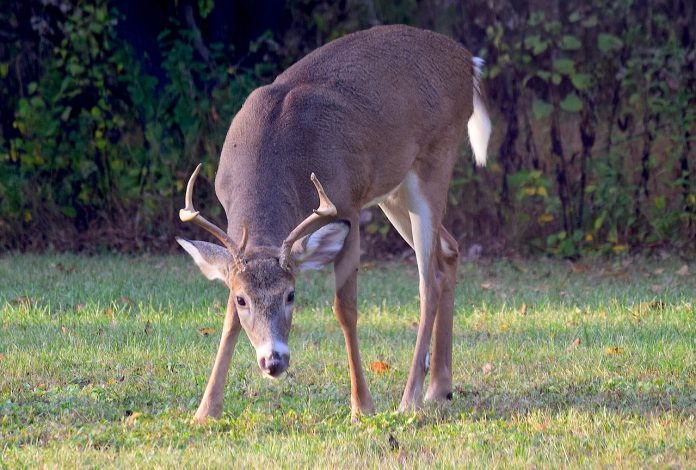Deer feast on vegetable gardens, flowerbeds, shrubs and trees. They will eat leaves, grass, bark, acorns, fruits, nuts, berries, lichens and fungi. Just one deer can consume between five and 10 pounds of plant material per day. It’s no surprise growing deer populations have been problematic for gardeners.
Gardeners can successfully manage deer damage with an integrated pest management approach, which could include planting deer-resistant plants, using repellents, taking advantage of seasonal hunting opportunities, deploying guard dogs and building fences.
Deer feeding habits
Understanding deer feeding habits can help you fine-tune your management plan. A good plan will recognize how available food sources change throughout the year due to weather conditions, seasons and other factors.
Consider the factors that affect deer feeding habits:
- Experience and previous movement patterns
- Nutritional needs
- Plant palatability
- Seasonal plant availability
- Weather conditions
- Geographic area
- Availability of alternative foods
If any one factor is stressing the local deer population, almost any plant is at risk for browsing. However, by observing and monitoring the habits of the herd feeding on your garden, you can determine which plants are preferred by deer in your area during different seasonal and climatic conditions.
Generally speaking, deer consume evergreen and dry leaves, as well as dormant buds during the winter; new growth on woody and herbaceous plants in the spring and summer and fruits and nuts from late summer to early winter.
By isolating preferred food sources throughout the year, you can implement a targeted management strategy to make your garden less appealing.
Frequently damaged plants
Some preferred food sources include apples, yews, rhododendrons, roses and hostas. By pairing deer favorites with undesirable plants, you may be able to camouflage them a bit and deter deer from feeding.
Deer-resistant plants
There are no plants that are completely safe under all conditions, but there are plants that are less preferred and even resistant under ideal conditions.
Deer-resistant plants frequently share common characteristics such as hairy, rough or spiny stem and leaf texture or the presence of aromatic compounds in the stems or leaves. Lavender and boxwood are avoided because of their aromatic qualities, while lamb’s ear and oakleaf hydrangea are distasteful to deer because of their leaf textures.
Penn State Extension suggests using the following deer-resistant plants in your landscape:
Trees
- Bottlebrush Buckeye
- Chinese Paper Birch
- Heritage River Birch
- Paper Birch
- Japanese Falsecypress
- Japanese Cedar
- Rocky Mountain Juniper
- Ironwood
- Colorado Blue Spruce
- Scotch Pine
- Douglas Fir
Shrubs, groundcovers and climbers
- Bearberry
- Pawpaw
- Barberry
- Butterfly bush
- Boxwood
- Bluebeard
- Japanese Plum-Yew
- Creeping Wintergreen
- Creeping Juniper
- Shore Juniper
- Leucothoe
- Nandina
- Allegheny Spurge
- Japanese Spurge
- American Elderberry
- Dwarf Sweet Box
- Periwinkle
- Chastetree
Annuals, perennials, bulbs
- Yarrow
- Monkshood
- Bugleweed
- Star of Persia
- Common Dill (annual)
- Snapdragon (annual)
- Columbine
- Rock-cress
- Jack-in-the-Pulpit
- Rock Cress
- Basket-of-Gold
- Berginia
- Plumbago
- Snakeroot
- Colchicum
- Lily-of-the-Valley
- Bleeding Heart
- Foxglove
- Wood Fern
- Barrenwort
- Euphorbia
- Fritillary
- Sweet Woodruff
- Lenten Rose
- Dame’s Rocket
- Hyacinth
- Deadnettle
- Lavender
- Sweet Alyssum (annual)
- Rose Champion
- Ostrich Fern
- Daffodil
- Flowering Tobacco (annual)
- Royal Fern
- Oriental Poppy
- Scented Geranium (annual)
- Husker Red Penstemon
- Russian Sage
- Lungwort
- Rhubarb
- Lavender Cotton
- Squill
- Lamb’s Ears
- Marigold (annual)
- Common Tansy
- Thyme
- Foam Flower
Other control methods
Fencing. Installing a fence is an expensive, but effective way to keep deer out of your garden. You can choose either a conventional woven wire fence or an electric fence. To weigh the pros and cons of both types, get more information from Penn State Extension.
Hunting. Taking advantage of seasonal hunting opportunities to thin the herd can help with deer management throughout the rest of the year.
Repellents. Repellents are effective when they are integrated into a management program that includes fencing, hunting and several types of repellents. You can try both area repellents and contact repellents. Area repellents do not have to be directly applied to the plant. Some examples are tankage (putrefied meat scraps), ammonium soaps, bone tar oil, blood meal and human hair. Contact repellents work by taste and must be applied directly to the plant. Some examples are putrescent egg solids, thiram and hot pepper sauce. These repellents work best if you apply them to the plant during the dormant season on dry days when temperatures are above freezing.
Guard dogs. A chained dog will not be able to deter deer outside of its range, but free-range dogs can deter deer from any part of your property. With the use of an underground electric fence, you can keep your dogs contained and discourage deer from entering your property. Penn State Extension suggests using herding breeds and long-haired breeds to maximize the effectiveness of this strategy year round.












I like how you said that you could either get a deer exclusion fence in traditional wire or with an electrical fence. We have been struggling quite a bit with deer eating our garden plants. My wife and I will have to look into getting a fence that maybe would help to keep the deer out so we can enjoy a nice harvest.
I like how you included that installing a deer fence is an effective way to keep deer out of your garden. My house is in an area that has a heavy deer population and I’m worried about them getting into my flower gardens. I’ll make sure to keep this in mind if I decide to have a deer fence installed.